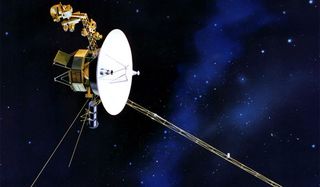
NASA will now foot the entire bill for the United States' production of plutonium-238 spacecraft fuel, which recently started up again for the first time in a quarter-century.
The space agency had been splitting costs for the reboot with the U.S. Department of Energy, which actually produces plutonium-238. But NASA is the only projected user of the stuff, so the arrangement changed in the White House's federal budget request for 2014, which was unveiled earlier this month.
"Since the [Obama] Administration has a 'user pays' philosophy, we are now in a position to pay for basically the entire enterprise, including the base infrastructure at DOE," NASA chief financial officer Beth Robinson said in an April 10 press conference. "We'll be partnering with DOE in the next couple of months to figure out how to best do this, and how to streamline the program to produce plutonium-238." [Nuclear Generators Power NASA Probes (Infographic)]
Plutonium-238 is not a bombmaking material, but it is radioactive, emitting heat that can be converted to electricity using a device called a radioisotope thermoelectric generator. For decades, RTGs have powered NASA probes to destinations in deep space, where sunlight is too weak and dispersed to be of much use to a robot.
For example, the agency's twin Voyager spacecraft, which are knocking on the door of interstellar space, are both RTG-powered. So is the Mars rover Curiosity, whose observations recently helped scientists determine that the Red Planet could once have supported microbial life.
The DOE stopped producing Pu-238 in 1988, after which NASA began sourcing the fuel from Russia. But the agency received its last Russian shipment in 2010, and supplies have been dwindling ever since, worrying many scientists and space-exploration advocates.
So NASA and the DOE have been working together on a Pu-238 restart, which officials from both agencies have estimated will cost between $75 million and $90 million over five years.
Get the Space.com Newsletter
Breaking space news, the latest updates on rocket launches, skywatching events and more!
This effort has made significant progress. NASA officials announced last month that researchers at the DOE's Oak Ridge National Laboratory in Tennessee had irradiated targets of neptunium-237 with neutrons, successfully generating small amounts of plutonium-238 — the nation's first in 25 years.
Scaling up from these early test activities shouldn't be too much of a chore, officials said.
"By optimizing the production process, it is estimated that 1.5 to 2 kilograms [3.3 to 4.4 pounds] per year will be produced by 2018. This amount will be enough to meet NASA's projected needs for future planetary missions. The Science budget request fully funds this requirement," NASA officials wrote in the agency's 650-page explanation of its 2014 budget request.
"For the first time, NASA’s request also includes $50 million to support the radioisotope power system development infrastructure through full-cost recovery mechanisms at the Department of Energy," they added.
Follow Mike Wall on Twitter @michaeldwall and Google+. Follow us @Spacedotcom, Facebook or Google+. Originally published on SPACE.com.
Join our Space Forums to keep talking space on the latest missions, night sky and more! And if you have a news tip, correction or comment, let us know at: community@space.com.

Michael Wall is a Senior Space Writer with Space.com and joined the team in 2010. He primarily covers exoplanets, spaceflight and military space, but has been known to dabble in the space art beat. His book about the search for alien life, "Out There," was published on Nov. 13, 2018. Before becoming a science writer, Michael worked as a herpetologist and wildlife biologist. He has a Ph.D. in evolutionary biology from the University of Sydney, Australia, a bachelor's degree from the University of Arizona, and a graduate certificate in science writing from the University of California, Santa Cruz. To find out what his latest project is, you can follow Michael on Twitter.
